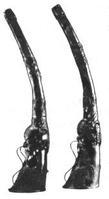How to play Gangdong
Gangdong, also known as Ganglin and Zhaling in Tibetan, and Dharma and Lama in Han, evolved from ancient horn-like musical instruments and is one of the instruments of Tibetan Buddhism. The tube body is mostly copper, but also silver. The shape is similar to the big horn, and it is a veritable leg-shaped horn.

When playing Gangdong, hold the upper end of the pipe body vertically with the left hand or the right hand, and the airflow enters from the mouthpiece to make a sound without a fixed pitch.
The copper-made steel hole has a humming sound, a rough tone, and a very loud volume. Two wind instruments are often used at the same time, first in turn, and then in an ensemble. The music has the meaning of calling the gods. It is mainly used for chanting music in Lama monasteries, Qiangmu performances and religious ceremonies, etc. It is a religious musical instrument commonly used in large Tibetan Buddhist monasteries.
The bone-made kangling has a slender pronunciation and a dark tone, and is often played with a single blow. It is mainly used on occasions such as lamas chanting the "jue" (jio) scriptures, holding sky burial ceremonies or wandering monks engaged in religious activities alone. Hold the upper end of the pipe body vertically by hand, the air flow enters from the mouthpiece to make a sound without a fixed pitch.
 渝公网安备 50010702504639号
渝公网安备 50010702504639号